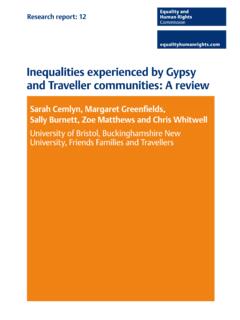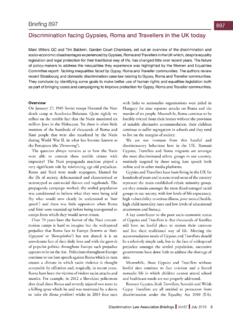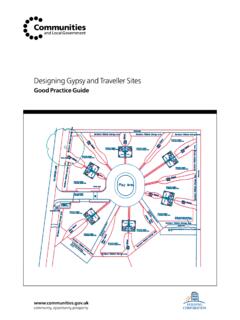Transcription of Race Evidence of health inequalities affecting black and ...
1 1 Race Evidence of health inequalities affecting black and minority ethnic people Demographics Population by Ethnic Group: Bradford District 20071 All People 497,400 100% White: British 354,800 White: Irish 3,300 White: Other White 10,600 Mixed: White and black Caribbean 3,300 Mixed: White and black African 800 Mixed: White and Asian 4,000 Mixed: Other Mixed 1,400 Asian or Asian British: Indian 14,800 Asian or Asian British: Pakistani 80,000 Asian or Asian British: Bangladeshi 5,900 Asian or Asian British: Other Asian 4,200 black or black British: black Caribbean 3,600 black or black British: black African 4,200 black or black British: Other black 500 Chinese or Other Ethnic Group: Chinese 2,800 Chinese or Other Ethnic Group: Other 3,300 There is no direct measure of migration but there are a number of proxy measures such as GP registrations and Office for National Statistics estimates.
2 Using a variety of these measures, 5000 to 8000 new long term international migrants have arrived in Bradford each year since In the Bradford district 63 languages are spoken3. National data 1 Office for National Statistics, 2007 & Bradford & Airedale JSNA 2 Bradford Joint Strategic Needs Assessment (JSNA) 3 BTHFT draft Single Equality & Human Rights Scheme, 2009 2 Type 2 diabetes is times more prevalent in South Asians than However, a Diabetes UK survey of South Asian members found that only 16% of those responding had attended a course to help manage their In the UK, men of black African and black Caribbean descent are three times more likely to develop prostate cancer than white men of the same Men are more likely to be overweight than women however, among Pakistani, Bangladeshi and black African people, women are less likely to be of normal/healthy weight than men (data available for England only).
3 7 Race for health highlights the following inequalities : Some 35% of African Caribbean men smoke, compared with 39% of white Irish men, 44% of Bangladeshi men and 27% of the general population. Infant mortality in England and Wales for children born to mothers from Pakistan is double the average. Young Asian women are more than twice as likely to commit suicide as young white women. Young black men are six times more likely than young white men to be sectioned for compulsory treatment under the Mental health Act. South Asian people are 50% more likely to die prematurely from coronary heart disease than the general population. Asian women aged 65 and over have the highest rate of limiting, long-term illness ( compared to 53% for all women aged 65 and over).
4 The prevalence of stroke among African Caribbean and South Asian men is 40% to 70% higher than for the general population 90% of children in the UK have visited a dentist. This compares with approximately 40% of Bangladeshi and 60% of Pakistani National patient surveys show lower levels of satisfaction amongst BME patients: GP Patient Survey results 2009/10: Patients very satisfied with the care from their GP or health centre by ethnicity: Irish 60%, British 56%, compared with Chinese 27%, Bangladeshi 28% and Pakistani 29%9. 4 Diabetes in the UK 2010, Diabetes UK 5 Survey of South Asian people with diabetes 2006: Access to healthcare services at a glance, Diabetes UK 6 Ben-Shlomo, Y.
5 , S. Evans, et al. (2008). "The risk of prostate cancer amongst black men in the United Kingdom: the PROCESS cohort study." European Urology 53(1): 99-105. 7 Equality & Human Rights Commission, How Fair is Britain? (2010) 8 Driving Forward Race Equality in the NHS (Race for health ) 9 GP Patients Survey 2009/2010 3 According to the NHS In Patient Survey, Asian/Asian British patients were 20% less likely to give a positive response to the question Overall, did you feel you were treated with respect and dignity while you were in the hospital? when compared to the White British Similar patterns emerge from a question regarding Emergency Departments. For example, other than White Irish patients, all ethnic minority patients were less likely to give a positive response to the question Overall, did you feel you were treated with respect and dignity while you were in the Emergency Department?
6 In particular, the Chinese/other patients were approximately 50% less likely to give a positive response when compared to White British From the same In Patient Survey, all ethnic minority patients, in comparison to white British patients, were less likely to give a positive response to the question Did the doctor treat you with respect and dignity? , with Asian/Asian British patients being 50% less likely and Chinese/other patients being 66% less likely to give a positive response. 12 gypsies and Travellers have a lower life expectancy than the rest of the population. Department of health research indicates the average life expectancy for a gypsy or traveller man is 50. This is associated with access to services, lack of trust, attitudes and other social factors.
7 gypsies and Travellers experience poorer health than the average population: bronchitis (40% prevalence compared to 10%) anxiety (38% prevalence compared to 13%) with women twice as likely to be anxious as men and asthma (65% prevalence compared to 40%).13 Local data In Bradford, South Asian 5 year old children have significantly higher levels of dental disease than their white peers living in areas of similar socio-economic status14. A health Needs Assessment of local African and African-Caribbean people carried out in 2002 recommended that there is a particular need for culturally appropriate services in respect of hypertension, stroke, diabetes, mental illness and Focus group work carried out with local black and Minority Ethnic (BME) women from 2009 until 2011 showed that many have had poor experiences of using local maternity 10 Report on the self reported experience of patients from black and minority ethnic groups, June 2009, DH and National Statistics, citing the National Survey of Adult Inpatients 2008/09 11 Ibid 12 Ibid 13 Parry G.
8 , Van Cleemput C. et al, The health Status of gypsies and Travellers in England, The University of Sheffield, October 2004. 14 Shahid (2006) The Oral health of 5 year old Children living in Bradford and Airedale tPCT 2006. 15 Time for Action: The health of African and African-Caribbean people in Bradford, a needs assessment, Feb 2002 16 Report not yet published 4 Older BME people: Current work shows that disproportionately low numbers of BME people use community hospitals, older people s mental health services and continuing health care Mental health : Locally disproportionately high people of Irish, White Other, African and African Caribbean ethnicities use mental health in-patient services. Staff: Analysis of workforce data at all four local trusts shows the following inequalities : Smaller proportion of Asian heritage staff than local population Smaller proportion of Pakistani heritage applicants shortlisted and appointed than white British applicants Low proportion of BME staff in non-clinical senior positions Disproportionately high numbers of BME staff facing disciplinary action Research in 2010 found that BME staff were almost twice as likely to be disciplined in comparison with white staff and the problem could be more common, as a web audit found that only 80 NHS trusts published annual data broken down by ethnicity as required by the Race Relations (Amendment) Act 2000.
9 Trusts need to develop robust systems for data collection and analysis relating to all aspects of employee relations .18 Staff surveys show that BME staff may be less satisfied at work than white staff: for example in NHS Bradford and Airedale s 2010 staff survey, 62% of BME staff believe that the trust provides equal opportunities for career progression or promotion, compared to 93% of white staff and 39% of BME staff feel there are good opportunities to develop their potential at work compared to 52% of white NHS Bradford and Airedale, Bradford District Care Trust and Bradford Teaching Hospitals have BME staff networks. 17 Equality Impact Assessment work carried out by BTHFT, NHSBA and BDCT 18 Archibong U.
10 And Darr A., The Involvement of black and Minority Ethnic Staff in Disciplinary Proceedings, March 2010, Centre for Inclusion and Diversity, University of Bradford. 19 CQC 2010 National NHS Staff Survey Results for NHS Bradford and Airedale










